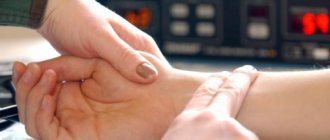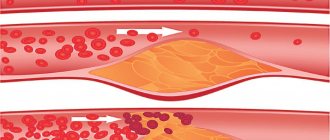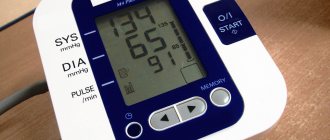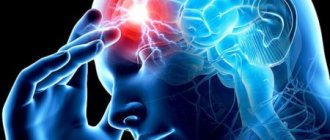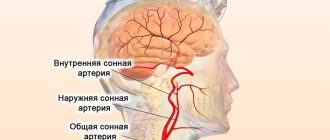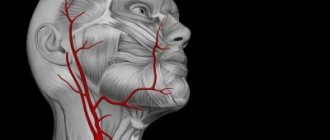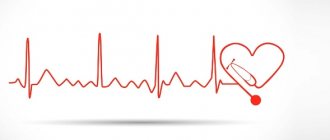The carotid artery in the neck is pulsating
1. How to palpate to distinguish the pulsation of the internal jugular vein from the pulse in the carotid artery?
Normally, the jugular venous pulse is not palpable.
If the venous pressure is extremely high, then in some cases you can feel gentle wave-like vibrations with your fingers.
A. Pressure on the supraclavicular region stops the jugular pulsation, but never eliminates the pulsation of the carotid artery.
However, there is one subtlety here that should be remembered. Very high and strong pulsation of the jugular vein does not disappear when pressing on the lower region of the supraclavicular space. In order to stop the high-amplitude pulsation of the jugular vein with high venous pressure, it is necessary to press at least on the middle of the neck (Fig.
Causes and factors of occurrence
The main cause of swelling and pulsation of the neck veins is right ventricular heart failure with stagnation of venous blood in the systemic circulation.
At the same time, stagnation in the veins of the neck is manifested by their expansion, swelling and visible systolic pulsation (positive venous pulse).
This pulsation occurs as a result of the return (regurgitation) of blood from the right ventricle to the right atrium.
The pulsation of the neck veins differs from the pulsation of the carotid arteries in its smaller amplitude and the absence of its sensation upon palpation. Also a distinctive feature is the dissonance between the pulsation on the radial artery and the pulsation of the veins in the neck: on the radial artery the pulse is usually weak, while on the neck the venous pulse wave is clearly and clearly visible.
Increased pulsation of the neck veins and their swelling can be observed in healthy people during stressful situations, neuroses, and excessive physical exertion.
Why is this happening
Rice. 8. Very intense jugular pulsation does not disappear with pressure directly above the clavicle, possibly because the sternocleidomastoid tendon prevents adequate compression of the jugular vein
b. Sudden and sharp pressure on the abdomen instantly makes the jugular pulsation more noticeable, but has no effect on the pulsation of the carotid artery.
How can you distinguish jugular pulsation from carotid pulsation based on the pulse wave contour?
If the most pronounced rapid impulse is directed inward (i.e., it represents a collapse), then the source of pulsation is the jugular veins. The most extensive and rapid pulse movements in the carotid artery are directed outward.
Pulsation of the neck veins may occur if you have the following health problems:
- Thrombosis of large venous trunks.
- Arrhythmia.
- Heart or vascular defect (congenital or acquired).
- Pericarditis.
- Heart failure.
- Emphysema.
- Mechanical impact on the superior vena cava (occurs with tumors or severe inflammation of neighboring organs).
- Goiter located behind the sternum.
- Aneurysm of the thoracic aorta.
- Atherosclerosis of the thoracic aorta.
- Some other problems.
Classification and characteristics
Signs of swelling and pulsation of the neck veins are:
- visible slow pulsation and swelling of the veins of the neck along the angle of the lower jaw and even in the sublingual area;
- in especially severe cases, swollen and dilated veins can also be found on the back of the hands;
- swelling of the veins of the neck during inspiration (Kusmaul's symptom);
- swelling of the veins of the neck when pressing on the area of the right hypochondrium;
- swelling in the neck area;
- visible heart pulsation in the area of the anterior chest wall, epigastrium, and liver.
What diseases does it occur in?
Swelling and pulsation of the neck veins can occur in the following pathological conditions:
- congenital and acquired heart and vascular defects (insufficiency of the tricuspid valve, aortic valve);
- heart failure;
- pericarditis (constrictive, exudative);
- cardiac tamponade;
- hepatojugular reflux;
- severe pulmonary emphysema;
- pneumothorax;
- compression of the superior vena cava by a tumor or pathologically altered neighboring organ;
- neoplastic process (tumor) in the mediastinum;
- aneurysm or severe atherosclerosis of the thoracic aorta;
- retrosternal goiter;
- thrombosis of large venous trunks;
- arrhythmias (complete transverse heart block, heart rhythm from the atrioventricular node with the occurrence of simultaneous contraction of the ventricles and atria).
Study
The primary study when a patient complains that a vein in the neck is pulsating is a palpation examination.
The doctor evaluates:
- central venous pressure;
- venous pulse.
Note that pulsation can be caused by disturbances in the outflow of blood in the veins (venous) or in the arteries (arterial).
The doctor determines this during the initial examination.
To establish a more accurate diagnosis, one or more of the following tests may be needed:
- MRI with contrast;
- Ultrasound of the neck and chest;
- puncture;
- UAC;
- duplex scanning of cervical vessels;
- multislice CT of the cervical and thoracic regions;
- CT scan of the skull.
It is important to know: the problem often affects overweight people, so the doctor also pays attention to the patient’s build.
Treatment
The pulsation of the veins in the neck is only a symptom, and not an independent disease, therefore, when identifying the final cause of the symptoms and making a diagnosis, the doctor treats the underlying disease.
When tumors are detected, therapy is aimed at their removal.
Heart failure and arrhythmia are treated with lifelong medication. In case of aneurysm, atherosclerosis and some other problems, the doctor may decide to perform an operation, but this practice is used if the vessels are severely pinched or blocked, which interferes with normal blood circulation.
If you notice a throbbing area on your neck once or twice, this does not mean there is a serious danger to your health.
But regularly occurring pulsation is a symptom that you should definitely tell your doctor about, even if nothing else bothers you.
Observation of the nature of pulsation of the veins of the neck
By the level and nature of pulsation in the veins of the neck, one can judge the condition of the right chambers of the heart. The pulsation of the internal jugular vein on the right most accurately reflects the state of hemodynamics. The external jugular veins may be dilated or collapsed due to extracardiac influences - compression, venoconstriction.
Observation is carried out with the patient lying down with the torso elevated - 30-45°, the neck muscles should be relaxed (Fig. 6).
Rice. 6. Visual determination of central venous pressure (in a patient, central venous pressure = 5 cm 5 cm = 10 cm water column)
Normally, pulsation is noticeable only in the area of the right supraclavicular fossa.
For each pulsation of the carotid artery, a double oscillation of the venous pulse is noted. Unlike the pulsation of the carotid arteries, the pulsation of the vein is smoother, is not felt during palpation and disappears if the skin above the collarbone is pressed.
In healthy people, in a sitting or standing position, pulsation of the veins of the neck is not visible.
By the upper level of pulsation of the right internal jugular vein, you can approximately determine the value of the central venous pressure: the angle of the sternum is located at a distance of about 5 cm from the center of the right atrium, therefore, if the upper level of pulsation is not higher than the angle of the sternum (only in the supraclavicular fossa), the central venous pressure is equal to 5 cm of water column, if the pulsation is not visible - the central venous pressure is below 5 cm of water.
Art. (in these cases, pulsation is noticeable only in a horizontal position of the body), if the level of pulsation is higher than the angle of the sternum, to determine the central venous pressure, add 5 cm to the value of this excess, for example, if the upper level of pulsation exceeds the level of the sternum angle by 5 cm, the central venous pressure is 10 cm ( 5 cm 5 cm) water.
Art. Normally, the central venous pressure does not exceed 10 cm of water. Art. If the pulsation of the neck veins is noticeable in a sitting position, the central venous pressure is significantly increased, at least 15-20 cm of water.
Art. The venous pulse normally consists of two rises (positive waves “a” and “V”) and two
When observing the pulsation of the neck veins, it is easiest to identify: 1. Increased central venous pressure - clearly visible pulsation of the veins of the neck in a sitting position, usually swelling of the external veins of the neck.2. A sharp decrease in central venous pressure (hypovolemia) in patients with a clinical picture of collapse or shock - absence of pulsation of the neck veins and collapse of the saphenous veins even in a horizontal position.3.
Atrial fibrillation - absence of the “a” wave of the venous pulse.4.
Causes of deviations when checking the pulse on the carotid artery
Checking the carotid pulse can demonstrate the presence of diseases:
- Stenosis, that is, narrowing of its lumen. This happens with atherosclerosis, when a deposit forms on the artery wall and partially blocks the blood flow. The pulsation becomes tense, and the outer vessel itself is palpated as a tuberous line.
- Inflammation of the artery. The pulsation in it has the same character as in the previous case, since the edematous tissue partially blocks the lumen of the vessel. But this pathology is complemented by painful sensations when palpating the artery.
- Myocardial infarction or myocarditis. In both diseases, the pulse is weak, with poor arterial filling. In the first case, cardiac arrest may occur.
- Carotid artery aneurysms. In one of its areas, a strongly pulsating, round-shaped formation can be felt.
- Hypertension, excessive production of thyroid hormones. With both pathologies, tachycardia occurs, that is, the pulsation is frequent, complete, and the vessel being examined is tense.
- Infections with fever. In this case, the heart seems to flutter, and tachycardia also occurs.
But to detect signs of each of these diseases, it is necessary to palpate the carotid artery along its entire length, and not just in the neck.
Rapid pulsation can also be caused by:
- stressful state,
- heat,
- dehydration, including due to diarrhea,
- binge eating,
- alcohol,
- an abundance of cigarettes smoked in a row,
- coffee,
- exercise stress.
The pulse becomes slower due to fatigue, lack of sleep or an unbalanced diet. A drop in blood sugar levels in a diabetic can cause the same symptom.
Anatomy of the carotid artery
The carotid artery, along some of its length, is adjacent rather superficially to the skin, so it can be easily and quickly palpated, and thus assess the presence or absence of cardiac activity in a person. This technique allows you to avoid wasting valuable resuscitation time trying to get to the chest and listen to heartbeats on the anterior chest wall.
So, the carotid artery is a paired blood vessel originating directly from the aorta on the left (more precisely, from its arch), and from the truncus brachiocephalicus on the right (brachiocephalic trunk). On both sides, the carotid artery, at this length called the common carotid artery, heading upward, passes to the right and left of the esophagus and trachea, and also slightly anterior to the cervical vertebrae.
Closer to the upper surface of the thyroid cartilage of the larynx (the most protruding part of the larynx, also called the “Adam's apple”), the common carotid artery divides into two branches - external and internal. From this level, the external branch is accessible to palpation, since it is covered only by the skin, subcutaneous fat and fascia, in contrast to the internal branch, which extends into the thickness of the muscles. It is on the external carotid artery that you can feel the pulsation by lightly pressing it against the deeper muscles of the neck.
anatomy of the carotid arteries and cervical arteries
If there is no pulse in the carotid artery
The absence of a pulse in the carotid artery is a dangerous condition, meaning that a person has suffered cardiac arrest. In this case, blood pressure drops to 0, blood stops circulating through the vessels and flowing to the internal organs. Resuscitation is required in the form of chest compressions and artificial respiration.
They are done before medical help arrives or within 30 minutes. If the heart does not beat, further resuscitation measures are pointless.
In a situation where a non-specialist does not detect a pulse in the neck, the reason may be weak cardiac activity and the fact that they are looking for it in the wrong place.
Causes of pulsation of blood vessels in the head
Treatment for pulsation in the head and neck may consist of prescribing analgesics, antihypertensive drugs, vascular drugs and nootropics, and in some cases surgery is necessary - removal of a tumor, aneurysm, implantation of an artificial heart valve. All patients with this symptom are recommended to normalize their regimen, eliminate stress and physical overload, and maintain a balanced diet and physical activity.
- venous. It is observed with tricuspid heart valve insufficiency, complete heart block, atrioventricular rhythm, stenosis of the right venous orifice, paroxysmal tachycardia. Manifests itself in the form of one-, less often two-wave systolic pulsation of the jugular vein synchronously with systolic contraction of the ventricles or after presystolic contraction of the atria;
- arterial. It is observed with aortic aneurysm, arterial hypertension, diffuse thyrotoxic goiter, and aortic valve insufficiency. It manifests itself as increased pulsation of the carotid artery and its branches.
Why you may need to measure
Checking the carotid pulse may be necessary if the person is unconscious
Even a seemingly healthy person needs to measure the pulse at the carotid artery or wrist from time to time. For example, this allows you to detect abnormalities in heart function in time and monitor the results of sports training. The pulse rate is equal to the frequency of contractions of the heart muscle.
In most cases, they resort to finding and measuring the heartbeat on the carotid artery during loss of consciousness. This action allows you to understand whether the organ’s work has stopped and determine further tactics of behavior: calling an ambulance, carrying out urgent resuscitation measures, etc.
Finding and systematically measuring the pulse on both sides of the neck is recommended for patients with the following diagnoses:
- thrombosis;
- atherosclerosis;
- carotid artery aneurysm;
- heart disease (for example, aortic insufficiency).
In some diseases, for example, congenital heart defects, the beat can be noticed visually without resorting to palpation. In aortic insufficiency, this phenomenon is called “carotid dancing.”
Description
The pulsation is accompanied by ringing in the ears, severe dizziness, panic attacks, it appears in the back of the head, in the temples. The pathological type of pulsation is quite long and constantly repeated. In this situation, you cannot hesitate; you must urgently contact a neurologist.
Sometimes unpleasant sensations appear in the vessels of the neck - this indicates arterial hypertension, arrhythmia, or heart disease. What should be done? Urgently undergo an examination to exclude a pathological type of pulsation.
Phoenix Heart
Our body works continuously throughout our lives. Even while we sleep or just relax, internal systems do not know rest. At the same time, it is impossible to monitor the activities of most of them without special devices, but the heart constantly transmits direct signals to us. We hear its beating in the chest, we feel an increase in rhythm, but the best way to monitor cardiac activity on our own is to measure the pulse. It is no coincidence that even in schools children are taught how to correctly find the pulse and practice this skill in medical training classes. True, without regular practice the skill is forgotten, and many only remember that the pulse can be felt on the wrist. To fill in the gaps and remember how to correctly find and measure bullets, read our tips.
What is pulse? Where to look for a pulse?
Pulse, or heart rate (HR), is the reflection of the heartbeat in the blood circulation. A completely natural phenomenon, considering that the heart causes blood to circulate rhythmically through the circulatory system. Each time the heart pumps out blood, the blood vessels fill more, and this can be felt by touching their walls. This can only be done where the vessels are as accessible to touch as possible, that is, there is no fat or muscle layer between them and the thin skin. That's why, before measuring your pulse, you need to find the right place to take it.
However, even this is not enough to measure your pulse. Because blood vessels differ not only in location, but also in size (volume) and functions performed. So the pulse can be different:
- Arterial pulse - vibrations of the walls of the arteries, that is, the vessels that carry blood from the heart to the internal organs.
- Venous pulse is a contraction of the veins, the task of which is to push blood “from the periphery” to the heart.
- Capillary pulse - even the smallest vessels experience vibrations from the heartbeat. But it is undesirable to determine the pulse from them due to many interferences. In particular, the blood pressure in the capillaries remains almost unchanged, and only strong changes can be noticed. Therefore, obvious changes in blood circulation are usually called capillary pulses: blue lips or nails, fingertips, etc.
Actually, the phrase “find the pulse” in most cases means the arterial pulse, while other types are needed in special medical research.
How to find and measure your pulse correctly?
There are not many places on the human body where these conditions are met. And there are even fewer ways to measure pulse that are available in everyday (non-clinical) conditions. In fact, you can measure your pulse yourself only by palpation, that is, using superficial tactile sensations. You can find and palpate the pulse in the following places on the body:
- At the wrist: the most common, or radial pulse (radial artery pulsation).
- On the ulnar artery: in another part of the wrist, a little higher.
- On the brachial artery: in the area of the elbow, on the inside of the arm, next to the biceps.
- On the axillary artery: passes in the armpit, hence the name “axillary pulse”.
- On the temples: above the eyebrow, where the temporal artery is visible.
- On the neck: the carotid artery makes it possible to perfectly feel the so-called “carotid pulse”.
- On the lower jaw: between its edge and the corner of the mouth (facial pulse).
- In the groin: on the inner thigh, “femoral pulse.”
- Below the knee: in the hollow in the bend of the leg, along the popliteal artery.
- On the feet: above the arch, in the middle of the instep or behind, just below the ankle.
In different circumstances, certain areas of the body are available that are suitable for manually measuring pulse.
How to correctly find the pulse on the hand,
measuring the finger on the hand. Most often, the pulse is measured precisely on the radial artery, in the area of the wrist, passing so close to the skin that it is visible to the naked eye. You can find and check the pulse in this place at any time, even for yourself:
- Turn your left hand palm up. It is the left one - in most cases they try to find the pulse on it. Ideally, the pulse on both hands should be the same, but in practice on the left hand, located closer to the heart, it can be seen better.
- Keep your left hand in this position at approximately chest height (you can place it on a horizontal surface, but do not rest it on it). Place the index and middle fingers of your right hand, straightened and folded together, lightly on the wrist of your left hand, just below the base of the thumb.
- Feel the artery under the fingertips of your right hand: it should feel like a thin tube under the skin, soft but elastic.
- Lightly press the fingers of your right hand on the artery of your left wrist - this will make the blood pushes inside the artery more noticeable.
- Mentally count the number of blood pumps that will occur within 1 minute. Another option: count only for 30 seconds, then double the amount.
Similarly, in the “mirror” image you can find the pulse on the second hand. A different pulse on the right and left arms indicates problems in the development and/or functioning of the cardiovascular system. On the right hand, the pulse may be weaker than on the left, or it may be felt asynchronously, with a delay.
Please note that you need to find the pulse with two relaxed fingers, the index and middle. It is incorrect to determine the pulse on the hand with the thumb of the other hand, because the pulsation in the thumb is also felt quite strongly. Therefore, it is easy to make a mistake and mistake the thumb pulse for the pulse on the hand. But by feeling the pulsation with your index and middle fingers, you will not be mistaken when measuring the pulse of yourself or another person.
How to correctly find the pulse on the carotid artery
The radial artery in the wrist is a prominent but not the thickest artery in the human body.
Therefore, it may not be palpable if a person has lost consciousness or lost a lot of blood. In such circumstances, the pulse is measured at the carotid artery and operates as follows: pulse at the carotid artery
- The patient should not be in an upright position; sit him up or lay him on his back.
- If you are right-handed, with the index and middle fingers of your right hand folded parallel, slowly move down the patient’s neck from top to bottom. Move from the base of the lower jaw to the place where the throat passes.
- The pulse should be felt in a small hole - in this place the pulsation is most pronounced.
- Do not apply too much pressure with your fingers to the artery, as this may cut off circulation and cause the patient to faint.
- For the same reason, they do not probe both carotid arteries at the same time, limiting themselves to one side, which gives a sufficient picture.
In addition to palpation of the wrist, carotid artery and other areas of the body listed above, the pulse is determined using a heart rate monitor, or, more simply, a pulsometer. The sensors of this device are attached to the chest, thumb or earlobe. Finding your pulse using a heart rate monitor is not difficult; just fasten it with a specially designed belt, after which the sensitive sensor will “grope” the body’s pulsation.
Why measure your pulse? Pulse rate
Finding and measuring your pulse is important, and in some situations, simply necessary. Pulse is one of the main signs of life, and in less extreme circumstances it helps to monitor health status, the performance of sports training, etc. As is known, normally the pulsation frequency corresponds to the frequency of the heartbeat (contraction of the heart muscle). And when palpating the pulse, it is important to know how to count the pulse correctly, and what pulse is considered normal:
- 60-90 beats per minute for a healthy adult;
- 40-60 beats per minute for physically trained adults and athletes;
- 75-110 beats per minute for adolescents over 7 years old;
- 75-120 beats per minute for preschoolers over 2 years old;
- 80-140 beats per minute for one-year-olds and younger;
- 120-160 beats per minute - this is the rate at which a newborn’s heart beats.
As you can see, as you age, your heart rate decreases due to the growth of your cardiovascular system. The larger and stronger the heart, the fewer contractions it needs to ensure blood flow. For the same reason, the pulse of athletes, that is, people accustomed to cardio exercise, is lower.
But pulse is an unstable parameter. It can change literally instantly under the influence of external and/or internal factors. The most common causes of heart rate changes are:
- Emotions.
The stronger they are, the faster the pulse. - Health status.
An increase in body temperature of just 1°C speeds up the pulse by 10-15 beats per minute. - Food and drinks.
Coffee, alcohol and other central nervous system stimulants speed up the heart rate, as do hot foods. - Body position.
The pulse of a lying person is slightly slower than that of a sitting person, and that of a sitting person is slower than that of a standing person. - Times of Day.
The maximum heart rate occurs between 8 and 12 am and from 6 to 8 pm. The slowest heart rate is at night.
And, of course, the heart rate increases when the body experiences physical activity. In this case, it is important not to exceed the maximum permissible value, so as not to overstrain the cardiovascular system. The maximum permissible heart rate is a purely individual parameter, depending on physical fitness, health status, body weight, and age. But it is customary to focus on age in order to correctly determine the maximum heart rate for each person:
Subtract your age from 220, for example, 220-30=190 - this is the maximum heart rate for a 30-year-old person. But this is the limiting value, and the optimal value will be 0.7 from the maximum, that is, 190x0.7=133. So during sports activities, it is advisable to keep your heart rate around 130-133 beats per minute. But if in everyday life, without much physical effort, your pulse “goes through the roof” or “does not reach” the average, then the right decision would be not to look for the pulse yourself, but to consult a doctor. A professional will measure your pulse using medical methods and determine the causes of tachycardia or bradycardia and prescribe adequate treatment. Be healthy and may your heart rate always be normal!
Source: kakimenno.ru
Treatment
The pulsation of the veins in the neck is only a symptom, and not an independent disease, therefore, when identifying the final cause of the symptoms and making a diagnosis, the doctor treats the underlying disease.
When tumors are detected, therapy is aimed at their removal. Heart failure and arrhythmia are treated with lifelong medication. In case of aneurysm, atherosclerosis and some other problems, the doctor may decide to perform an operation, but this practice is used if the vessels are severely pinched or blocked, which interferes with normal blood circulation.
If you notice a throbbing area on your neck once or twice, this does not mean there is a serious danger to your health. But regularly occurring pulsation is a symptom that you should definitely tell your doctor about, even if nothing else bothers you.
To eliminate throbbing pain, anti-inflammatory and painkillers (paracetamol, ibuprofen) are prescribed. Muscle relaxants are also used in treatment: (diazepam) or their natural analogues: chamomile, bergamot, valerian, basil, peppermint and some others.
For treatment and prevention, special orthopedic pillows for sleeping and collar-corsets are used during wakefulness.
For prevention, exercises to relax the neck muscles and therapeutic exercises are indispensable.
Treatment depends on the underlying pathology; therapy for venous pulsation is not carried out separately. Most often, this complaint is associated with diseases of the heart and lungs, and of moderate or severe degree. If there is a suspicion or the diagnosis is known, you should immediately consult a doctor. Patients usually require hospitalization.
The list of drugs prescribed in such cases is very wide. Patients are prescribed diuretics (Furosemide, Spironolactone, Indapafone), sartans (Losartan, Irbesartan, Valsartan), beta blockers (Bisoprolol, Nebivalol), ACE inhibitors (Enalapril, Lisinopril), Ivabradine, antiarrhythmics. Metabolic drugs are indicated - Preductal, Mildronate. In the treatment of heart pathologies, products containing nitroglycerin, for example, Nitromint, are also used.
- If tamponade develops, emergency assistance with a puncture and drainage of the heart cavity is required.
- In the case of pericarditis, tactics depend on its type. Patients also require drainage of the pericardial cavity with evacuation of fluid. Anti-inflammatory drugs and antibiotics are prescribed.
- Surgical interventions can be performed to restore the heart rhythm, replace its valves, and replace the enlarged aorta.
- In case of oncological pathologies, the tumor is removed, and patients are prescribed radiation and chemotherapy. In the case of goiter, a study of the level of thyroid hormones is carried out, followed by the prescription of appropriate medications or surgical intervention.
- For the treatment of bronchial asthma or COPD, inhalers with a bronchodilator effect are required (Salbutamol, Seretide, Fluticasone, etc.). Antihistamines and mast cell stabilizers (Montelukast, Zofirolukast) are used as adjuncts.
- Treatment of pneumothorax requires hospitalization. Doctors drain the lung cavity.
- For emphysema, preventive treatment is carried out with the prescription of herbal medicines, physiotherapy, and lifestyle changes are necessary.
- For dysfunction of the autonomic nervous system, medications are prescribed by a psychotherapist. Anxiolytics (Tofisopam, Alprazolam), antidepressants (Sertraline, Escitalopram) may be required.
When tumors are detected, therapy is aimed at their removal.
Heart failure and arrhythmia are treated with lifelong medication. In case of aneurysm, atherosclerosis and some other problems, the doctor may decide to perform an operation, but this practice is used if the vessels are severely pinched or blocked, which interferes with normal blood circulation.
If you notice a throbbing area on your neck once or twice, this does not mean there is a serious danger to your health.
But regularly occurring pulsation is a symptom that you should definitely tell your doctor about, even if nothing else bothers you.
How to measure your pulse correctly
Pulse measurement is one of the important components of diagnosing cardiovascular diseases. It is necessary to monitor changes in heart rate during sports activities to prevent overloading the body. The pulse measurement algorithm is quite simple, so the procedure is easy to carry out independently.
- Peculiarities
- How to measure on the radial artery
- Checking the heartbeat in the carotid artery
- How to check children's pulse
- Using a heart rate monitor
| Low pulse: causes and signs |
| Rapid pulse and heartbeat: signs and symptoms |
Increased heart rate with normal blood pressure How to quickly lower your heart rate at home Heart rate table for children - on the wrist (radial artery);
- on the brachial artery;
- in the armpit area;
- on the temporal areas;
- on the neck;
- in the groin area;
- in the popliteal fossa;
- on the feet.
Peculiarities
During heart contractions, rhythmic vibrations of the walls of blood vessels occur, which is called the pulse. It is determined by taking measurements in the area of the projection of large arteries.
Pulse rates for a person at rest range from 60 to 90 beats per minute. When the indicator decreases, bradycardia is diagnosed, and when it increases, tachycardia is diagnosed. When taking measurements, the patient’s body temperature should be taken into account, since when it increases by one degree, the pulse accelerates by 10 beats per minute.
You can feel the heartbeat in an adult in several places on the body:
How to measure on the radial artery
The procedure at home is carried out using fingers or with a special heart rate monitor that measures blood pressure and pulse. The second method is more accurate. If you need to take measurements often, you should think about purchasing a device. Moreover, it is intended not only for athletes, but also for patients with cardiovascular diseases.
The technique for measuring at home by palpation is as follows:
- We check for the presence of symmetrical pulsation in paired arteries located on different arms. Differences in rhythm may be due to vascular pathologies, compression of the artery by lymph nodes or a tumor, dilated aorta. If the dynamics are positive, we measure the pulse on either side.
- The procedure is carried out by placing two fingers on the artery - the index and middle - without excessive pressure.
- To obtain a reliable result, it is enough to count for 30 seconds and then multiply the resulting figure by two. But if you wish, you can measure your pulse and a full minute.
Checking the heartbeat in the carotid artery
They resort to measuring heartbeats on the carotid artery if they cannot be palpated on the wrist. This happens due to loss of consciousness of the patient or the presence of sclerotic plaques on the radial artery.
The action algorithm is as follows:
- We lay the examined patient on his back or sit him on a chair.
- Place your straight middle and index fingers together. Slowly move them along the neck, moving from the base of the lower jaw to the beginning of the throat.
- The pulse should be felt in a small submandibular fossa.
- Using light pressure, we measure the number of blows according to the standard pattern.
Study
The primary study when a patient complains that a vein in the neck is pulsating is a palpation examination.
Note that pulsation can be caused by disturbances in the outflow of blood in the veins (venous) or in the arteries (arterial). The doctor determines this during the initial examination.
To establish a more accurate diagnosis, one or more of the following tests may be needed:
- MRI with contrast;
- Ultrasound of the neck and chest;
- puncture;
- UAC;
- duplex scanning of cervical vessels;
- multislice CT of the cervical and thoracic regions;
- CT scan of the skull.
It is important to know: the problem often affects overweight people, so the doctor also pays attention to the patient’s build. How is the presence of fat related to the pulsation of veins?
Fat fiber directly affects the cardiovascular system: on the one hand, fat is deposited around the heart, making it difficult to function; on the other hand, the heart has to work much harder, because there are much more tissues in the body of a full person and more blood also needs to be transferred.
- central venous pressure;
- venous pulse.
Note that pulsation can be caused by disturbances in the outflow of blood in the veins (venous) or in the arteries (arterial).
The doctor determines this during the initial examination.
It is important to know: the problem often affects overweight people, so the doctor also pays attention to the patient’s build.
What do the indicators depend on?
Average heart rates for people of different ages
It is not enough to find and measure the pulse in the carotid artery. You need to know in which case the frequency is considered normal and when there are deviations.
The following indicators are normal for different categories of people:
- healthy adult – 60-90 beats per minute;
- physically trained adult and professional athlete – 40-60 beats per minute;
- teenager over 7 years old – 75-110 beats per minute;
- preschooler aged 2-7 years – 75-120 beats per minute;
- child under 2 years of age – 80-140 beats per minute;
- newborn baby - 120-160 beats per minute.
As the body grows and the heart muscle gradually strengthens, the frequency of contractions of the organ decreases. People who lead a sports lifestyle, who are accustomed to intense and constant cardio exercise, have a lower heart rate than those who neglect sports.
Even in a healthy person, the heart rate can change dramatically due to external and internal factors:
- Times of Day. People's pulses are most frequent in the morning from 8-12 o'clock and in the evening from 18-20 o'clock. At night, the heart rate decreases.
- Being in a certain position. The pulse slows down if a person is in a lying position, and increases when he takes a sitting position. The maximum heart rate is for a standing and walking person.
- State of the nervous system. During an emotional outburst, anxiety, or excitement, the pulse increases. It slows down, when the nervous system returns to normal, the person calms down.
- Nutritional features. If you systematically include drinks that stimulate the central nervous system in your diet, your heart rate will accelerate. These include alcohol and coffee.
- Increase in general body temperature. It has been scientifically proven that when the temperature increases by 1 degree Celsius, it helps to speed up the heart rate by 10-15 beats per minute.
You may notice an increase in heart rate during exercise. It is not recommended to overuse intense training. Otherwise, the cardiovascular system is overstrained and the risk of organ failure increases.
First aid
Emergency assistance for venous pulsation is often required.
- In case of pneumothorax, you must call an ambulance; if the wound is open, it must be covered with a bandage (preferably sterile); in case of valve pneumothorax, you need to puncture the damaged area with a sterile needle.
- If cardiac tamponade or aneurysm rupture is suspected, urgent hospitalization is also required. Patients experience pale skin, decreased blood pressure, increased heart rate, and shortness of breath.
- When an aneurysm ruptures, unbearable pain occurs in the thoracic region with radiation to the lower back. It is important to call an ambulance; before it arrives, you need to provide the patient with peace, an influx of oxygen, and give an analgesic (Baralgin, Analgin, Tramadol).
Heart rate indicators
In healthy people, the pulse in the carotid artery is easily palpable, especially in the carotid triangle and above the carotid tubercle. At the same time, the pulse is uniform, the arteries themselves are even, smooth and elastic. All of the above qualities are similar on both sides.
- In a person who remains in a calm state for a long time, during sleep the pulse rate slows down and blood pressure decreases. In case of emotional and physical stress, pulsation, on the contrary, increases and becomes more frequent.
- In pathologies, the filling of the arteries and the frequency of pulse waves decrease on one or both sides. The second situation can be observed in a victim with low peripheral vascular resistance, a drop in blood pressure (loss of consciousness, sudden cardiovascular failure, shock), a decrease in the contractile function of the heart muscle (myocardial inflammation, myocardial infarction). The absence of a pulse on both sides indicates a decrease in pressure to zero as a result of critically low peripheral resistance, a sudden drop in the stroke volume of the heart, or a complete cessation of heart function.
- A large full pulse is observed with a hyperkinetic type of blood circulation. Fast, galloping - with aortic insufficiency.
- A tense pulsating rhythm (carotid dancing) occurs with hypertension, atherosclerosis in the elderly, and with arteritis. In some cases, the surface of the vessels may be heterogeneous with the presence of compactions, which also indicates sclerosis.
Due to the fact that the carotid artery plays one of the main roles in the body, its damage is extremely dangerous to health. Bleeding from it can lead to death in 2-3 minutes if it is not stopped in time and the victim is not taken to the hospital, where he will receive qualified medical care. It should be understood that with such serious injury, even doctors are not always able to help.
The vein on the right side of the neck is pulsating
1. How to palpate to distinguish the pulsation of the internal jugular vein from the pulse in the carotid artery?
Normally, the jugular venous pulse is not palpable.
If the venous pressure is extremely high, then in some cases you can feel gentle wave-like vibrations with your fingers.
A. Pressure on the supraclavicular region stops the jugular pulsation, but never eliminates the pulsation of the carotid artery.
However, there is one subtlety here that should be remembered. Very high and strong pulsation of the jugular vein does not disappear when pressing on the lower region of the supraclavicular space. In order to stop the high-amplitude pulsation of the jugular vein with high venous pressure, it is necessary to press at least on the middle of the neck (Fig.
If the venous pressure is extremely high, then in some cases you can feel gentle wave-like vibrations with your fingers.
Why do neck veins swell?
Rice. 8. Very intense jugular pulsation does not disappear with pressure directly above the clavicle, possibly because the sternocleidomastoid tendon prevents adequate compression of the jugular vein
b. Sudden and sharp pressure on the abdomen instantly makes the jugular pulsation more noticeable, but has no effect on the pulsation of the carotid artery.
How can you distinguish jugular pulsation from carotid pulsation based on the pulse wave contour?
If the most pronounced rapid impulse is directed inward (i.e., it represents a collapse), then the source of pulsation is the jugular veins. The most extensive and rapid pulse movements in the carotid artery are directed outward.
How to determine the presence of a pulse in the carotid artery in a victim
Determining the presence of a pulse in the carotid artery of an injured and unconscious person is more convenient than looking for it at a critical moment on the wrist:
- The patient must be positioned so that his head, chest and legs are approximately at the same level.
- You need to unbutton the collar of your clothing to ensure free breathing.
- The victim's head is turned to the right side.
- With two closed fingers, they feel his Adam’s apple and move the pads to the left to the place where the pulsation is felt.
- It is necessary to count the number of vibrations of the vascular wall per minute, and, if possible, evaluate the filling of the artery, rhythm and tension.
The last three criteria are assessed as follows:
- Rhythm is determined by the time intervals between beats. Normally, the pulse quickens as you inhale and slows down as you exhale. This is especially evident among young people.
- Filling is determined by the degree of pressure on the artery in order to feel the vibrations of its walls. If they are felt with light pressure, everything is fine. When you have to try to feel the tremors, this means an incomplete pulse.
- The voltage is calculated not on the carotid artery, but on the vessel in the wrist area. Press on it until the pulsation stops, then release. The degree of tension depends on how much effort needs to be applied so that vibrations are not felt at the point of pressure.
Diagnostics
Diagnosis begins with a history and general examination of the patient. The range of other laboratory and instrumental methods is wide:
- General blood and urine analysis.
- Biochemistry of blood.
- Ultrasound of the heart and blood vessels, abdominal organs, thyroid gland.
- Bicycle ergometry.
- Holter monitoring.
- X-ray of the chest organs.
- Spirography.
- Electrocardiogram.
- Study of the hormonal status of the body.
To clarify the diagnosis, computed tomography or magnetic resonance imaging may be required. If an oncological disease is suspected (with paraneoplastic syndrome), patients are prescribed a wide range of studies - ultrasound of the pelvic organs, invasive methods of examining the intestines, fibrogastroscopy with tissue biopsy.
Comprehensive research may also be required.
Diagnostic accuracy when contacting a competent specialist reaches 100%. The examination, depending on the nature of the problem, costs rubles.
